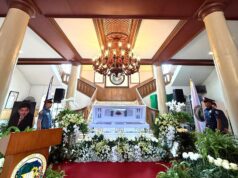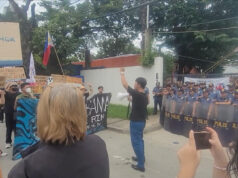CLARK FREEPORT – Apparently seeing more glitches at the Ninoy Aquino International Airport (NAIA) in Manila, Transportation and Com-munication Sec. Jose De Jesus has ordered Clark International Airport Corp. (CIAC) president Victor Jose Luciano to keep the DMIA here always open to passengers of diverted inter-national and domestic flights.
Luciano said the order also included hotel accommodations for passengers in case they would be stranded over long periods, as well as land transport should they opt to reach Metro Manila by bus instead of a longer wait for their aircraft to be cleared to flight to NAIA.
Luciano said the orders were issued pending the formulation of contingency plans to help passengers being stranded at the DMIA here and other airports in the country arising from problems that prevent their international or domestic flights immediately landing at the NAIA.
Since last June, flights of hundreds of passengers bound for NAIA were diverted to the DMIA. Many of the passengers were noted to have taken buses to Metro Manila instead of waiting for their aircraft to be cleared to proceed to NAIA.
Malfunctioning navigational equipment and runway visibility problems due to the worsening pollution in Metro Manila were blamed for the recent frequent diversion of flights. Most of the flights were diverted to the DMIA here, only 80 kilometers north of the capital.
“The instruction is for us to always accommodate, as we did in the recent weeks, the diversion of international and domestic flights following aging-navigational problems at the NAIA. This would include also preparing hotel accommodations and even land transport service for the passengers,” Luciano said.
Luciano said the order of De Jesus was based on Civil Aeronautics Board (CAB) Memorandum Circular No. 62 which tasks all air carriers operating scheduled services in the Philippines to “ensure the comfort and convenience of passengers during long tarmac delays at departure, destination and diversion airports, through the provision of adequate food, water and lavatories and the proper deplaning of passengers when required.”
Luciano said that Department of Transportation and Communication (DOTC) now requires airlines to give food and water to passengers during long tarmac delays. “After three hours of being stranded, the passengers can deplane and ferried by land to NAIA where welcomers are expected to be in wait,” he said.
“The DOTC now wants air carriers to submit a contingency plan for long tarmac delays. The DMIA is quite prepared for this, since we have all the navigational equipment as well as a radar that does even better than what’s at the NAIA,” he said.
De Jesus met recently with officials from the NAIA, the Civil Aviation Authority of the Philippines (CAAP), Manila International Airport Authority (MIAA), Civil Aviation Board (CAB), the Department of Trade and Industry (DTI) and the CIAC for the formulation of rules and procedures for airline passenger protection during long tarmac delays during flight diversions.
CAB Executive Director Carmelo Arcilla that the new rules and prodecures will be tackled in a conference slated on July 27 at the CAB board room.
Meanwhile, Luciano said he has already met with ground handlers at the DMIA to make sure they are ready to accommodate stranded passengers.
The DMIA is now on 24-hour operation, is on course in its development as a premier gateway of the Philippines in the next 10 years.
It is one of the biggest aviation complexes in Asia with its two 3.2 kilometer parallel runways that will be extended to 4 kilometers to accomodate new generation wide-bodied aircraft.
The DMIA is certified by the International Civil Aviation Organization (ICAO) with ratings of Category I for Precision Approach Runway and Category IX for the Emergency Services. It is well equipped with a Terminal Radar Approach Control, Instrument Landing System, Navigational Aids, Meteorological Equipment, and Complete Airfield Lighting System.
Luciano said the order also included hotel accommodations for passengers in case they would be stranded over long periods, as well as land transport should they opt to reach Metro Manila by bus instead of a longer wait for their aircraft to be cleared to flight to NAIA.
Luciano said the orders were issued pending the formulation of contingency plans to help passengers being stranded at the DMIA here and other airports in the country arising from problems that prevent their international or domestic flights immediately landing at the NAIA.
Since last June, flights of hundreds of passengers bound for NAIA were diverted to the DMIA. Many of the passengers were noted to have taken buses to Metro Manila instead of waiting for their aircraft to be cleared to proceed to NAIA.
Malfunctioning navigational equipment and runway visibility problems due to the worsening pollution in Metro Manila were blamed for the recent frequent diversion of flights. Most of the flights were diverted to the DMIA here, only 80 kilometers north of the capital.
“The instruction is for us to always accommodate, as we did in the recent weeks, the diversion of international and domestic flights following aging-navigational problems at the NAIA. This would include also preparing hotel accommodations and even land transport service for the passengers,” Luciano said.
Luciano said the order of De Jesus was based on Civil Aeronautics Board (CAB) Memorandum Circular No. 62 which tasks all air carriers operating scheduled services in the Philippines to “ensure the comfort and convenience of passengers during long tarmac delays at departure, destination and diversion airports, through the provision of adequate food, water and lavatories and the proper deplaning of passengers when required.”
Luciano said that Department of Transportation and Communication (DOTC) now requires airlines to give food and water to passengers during long tarmac delays. “After three hours of being stranded, the passengers can deplane and ferried by land to NAIA where welcomers are expected to be in wait,” he said.
“The DOTC now wants air carriers to submit a contingency plan for long tarmac delays. The DMIA is quite prepared for this, since we have all the navigational equipment as well as a radar that does even better than what’s at the NAIA,” he said.
De Jesus met recently with officials from the NAIA, the Civil Aviation Authority of the Philippines (CAAP), Manila International Airport Authority (MIAA), Civil Aviation Board (CAB), the Department of Trade and Industry (DTI) and the CIAC for the formulation of rules and procedures for airline passenger protection during long tarmac delays during flight diversions.
CAB Executive Director Carmelo Arcilla that the new rules and prodecures will be tackled in a conference slated on July 27 at the CAB board room.
Meanwhile, Luciano said he has already met with ground handlers at the DMIA to make sure they are ready to accommodate stranded passengers.
The DMIA is now on 24-hour operation, is on course in its development as a premier gateway of the Philippines in the next 10 years.
It is one of the biggest aviation complexes in Asia with its two 3.2 kilometer parallel runways that will be extended to 4 kilometers to accomodate new generation wide-bodied aircraft.
The DMIA is certified by the International Civil Aviation Organization (ICAO) with ratings of Category I for Precision Approach Runway and Category IX for the Emergency Services. It is well equipped with a Terminal Radar Approach Control, Instrument Landing System, Navigational Aids, Meteorological Equipment, and Complete Airfield Lighting System.



